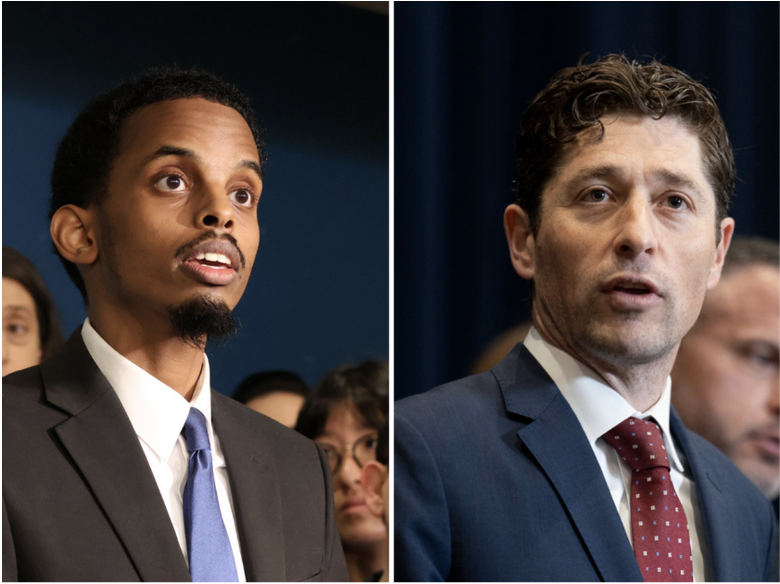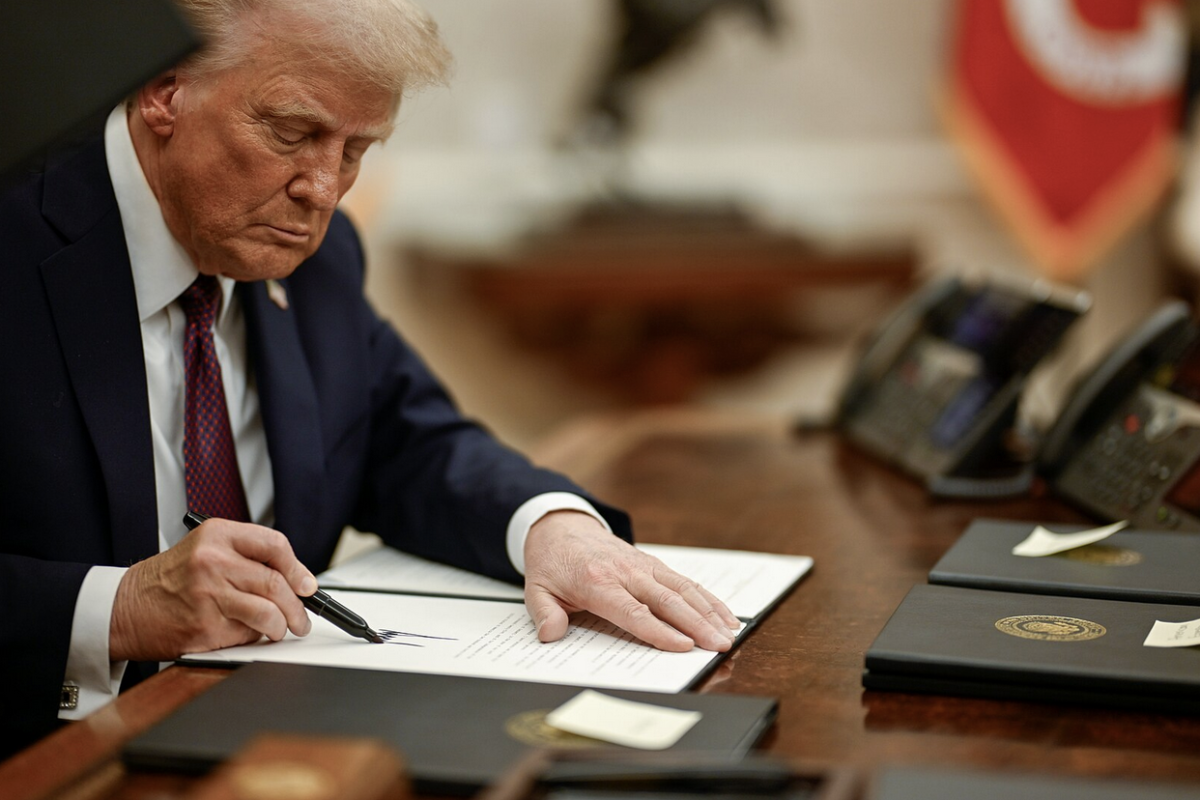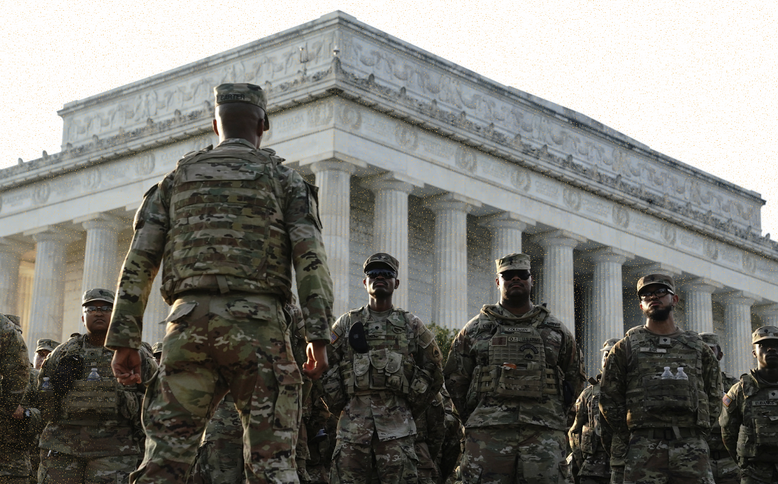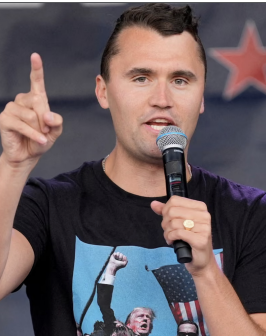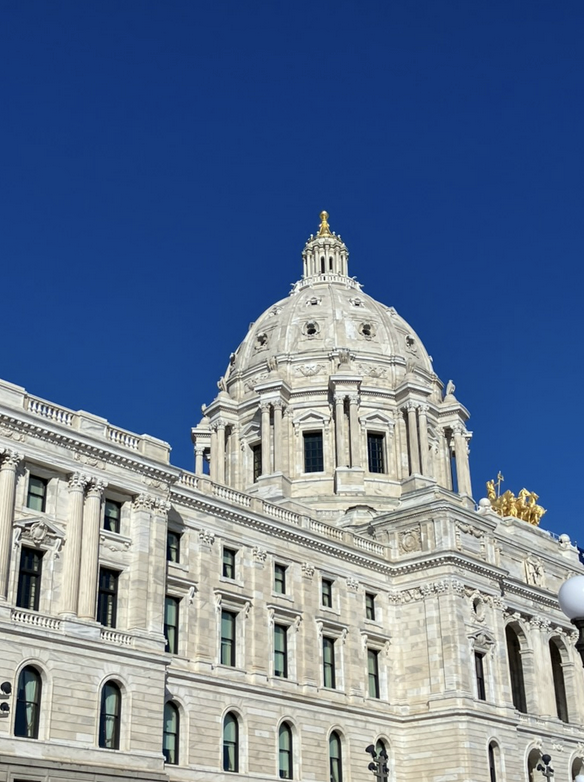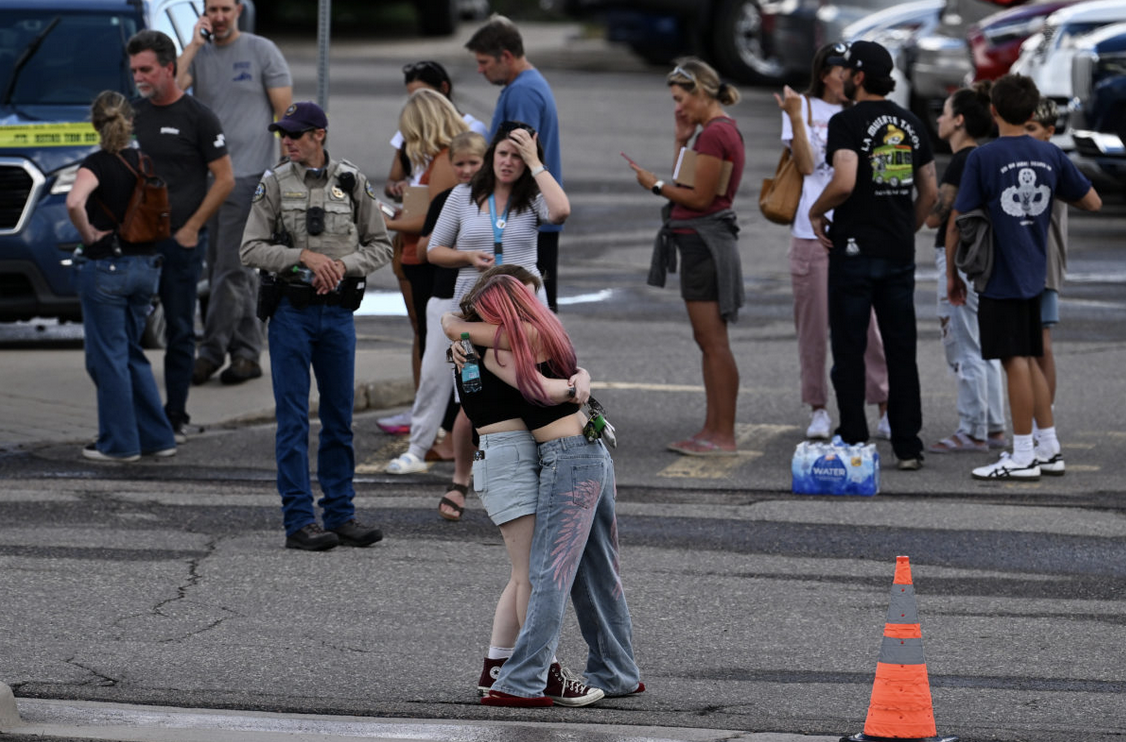Two Children Dead in Act of Gun Violence at Annunciation, Breck Students Walk Out
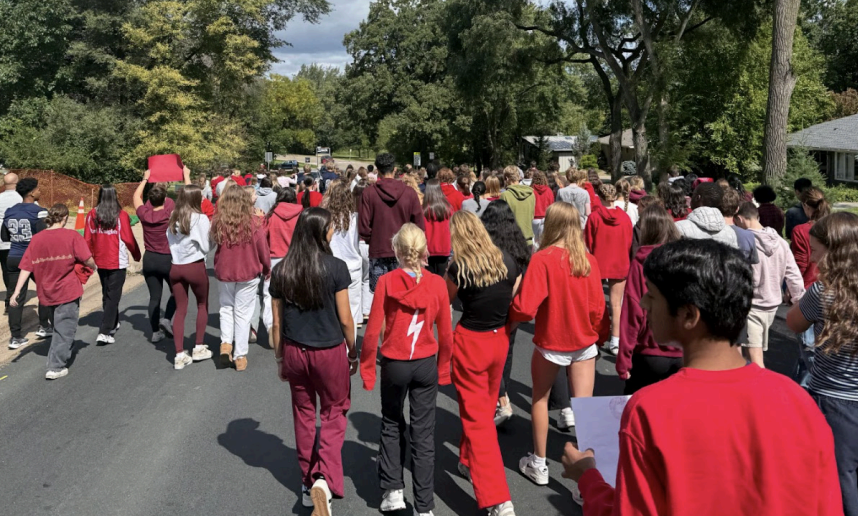
On the morning of August 27, 2025, Breck Upper School students of all grade levels reported to their camp activity days: freshmen to their advisory scavenger hunts, sophomores to a local ropes course, juniors to Boom Island in Minneapolis for bowling and volunteering, and seniors to the Breck Field House for a day-long bonding retreat that would soon be cut short.
The whispers of jittery seniors, excited about the start of their final year of high school, filled the air. We introduced ourselves to familiar faces, exchanging smiles and the occasional eye-roll as two enthusiastic representatives from Youth Frontiers led us through a series of ice-breaking activities. We participated in a grade-wide “rock-paper-scissors,” or in this case “giant-wizard-elf” tournament, followed by a chaotic rendition of duck, duck, goose. The mood was undeniably awkward, but it was happy, exactly what one would expect among children as a new school year starts to unfold.
But as we settled in for another collaborative relay-race style activity, Dean Wanless entered the gym. Whispering a message to one of the retreat leaders, she started towards the center of the group with an announcement. Her expression was grave, and as she refused the microphone, we began to realize that this was not a part of the retreat. Her words, “There has been a shooting at Annunciation Catholic in Minneapolis,” echoed deafeningly through a now-silent gym.
A five minute break turned into an hour. Tears fell from widened eyes. The whispers of excitement from earlier now morphed into shaky phone calls, hurried text messages, and hushed conversations that spread through our hallways like a ripple of unease. The local news was turned on bleakly, and painful hugs were shared, even between classmates who had barely exchanged words before. Those present at Annunciation that morning were Breck’s neighbors, our siblings, our children, and our friends. “Knowing so many people who go there…it is so sad and horrific that this is what our world has come to,” says one Breck student. As the seniors headed somberly back into the Field House, it became clear that something within us had shifted.
The following days were heavy as more news spread about the tragedy and the lives lost. “These past few weeks have made me incredibly sad, disappointed, and angry,” says Max Vollmer (‘27). Many of us attended the vigils held around the city. We made cards expressing sympathy for the Annunciation community members affected by the violence. “My empathy extends to the children who had to witness this…This cannot happen again,” says another Breck student. We tied green and blue ribbons to neighborhood light posts and trees. We reached out to each other with messages of heartbreak, of mourning, and of love.
The joy of the first week of school had barely begun before it was replaced by resolve, but also a desire for real change. “The only consistent variable in all shootings and gun violence is the gun…That is not a political opinion. That is a fact,” says a Breck student. With the help of the Student Diversity and Inclusion Council, Breck students channeled their desire for change into a walk-out.
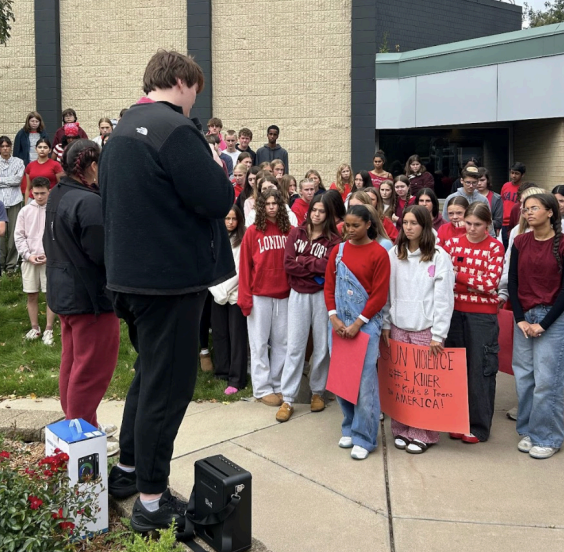
Following the tragedy that was the Annunciation shooting, Breck’s Student Diversity and Inclusion Council quickly worked to organize an Upper School-wide walkout to protest gun violence in schools. Breck worked in tandem with the organization Students Demand Action to participate in the nationwide protest occurring on Friday, September 5th at 12:00pm.
Following assembly, students gathered outside the theater and heard from the SDIC leaders. We then listened to a heartfelt and somber anecdote from senior Helen Mahar, who was personally impacted by the Annunciation tragedy.
The students then took to the streets, together as one, signs held high. We marched through the Highway 100 parking lot, up the road, and congregated at the intersection of Ottawa and Glenwood. This spot is intentional, and it has become a symbol for student activism at Breck over the past few years. It is very visible to everyone driving by, and allows our voices to reach beyond our own community. Once students made it to the top of Glenwood, we had a moment of silence for 8-year-old Fletcher Merkel and 10-year-old Harper Moyski, the two students that were killed in the Annunciation shooting. During the moment of silence, the handmade signs students were holding up received many honks from cars driving by in solidarity for our cause. About 30 seconds in, one driver reacted negatively, flipping off the group. Students were taken aback by the sudden gesture, especially in the midst of such a solemn moment, but the silence carried on. The interruption served as a reminder of the deep divisions around this issue, but it also underscored the importance of our presence and persistence in the face of adversity. We heard from our SDIC leaders once more, who reminded us that while this tragedy is heartbreaking, it also calls on us to take action and be part of creating change.
The group of students then walked back down to Breck, where we met in the Melrose Center to hear from our Golden Valley representative, Mike Freiberg, who spoke briefly about his personal experience with advocating for gun control. Freiberg reminded students that it is “so important that you hold your elected officials accountable on this issue.”
And our SDIC leaders were prepared to do exactly that. Students’ final action in the walkout was adding our signatures to a letter that was written by students advocating for gun control and restrictions on purchasing firearms that was sent to the Minnesota legislature calling for change.
The walkout ended on a note of action and empowerment, as students recognized the power of their voices. From marching through the streets to signing the advocacy letter, Breck students demonstrated that even in the face of tragedy, they can make a difference and stand united against gun violence.
The Annunciation shooting was the 44th of its kind in 2025, according to a CNN analysis. It sparked intense reactions across the country. Immediately, White House officials, President Trump, Vice President Vance, and so many others expressed their sympathy and offered their prayers. In a formal proclamation, President Trump announced that all flags were to be flown at half mast through August 31 as “a mark of respect for the victims.” Former presidents and congress members shared their condolences on social media while governors and mayors from across the country and political spectrum all came together calling for unity and mourning. Federal agencies also pledged assistance and resources to help the affected communities and assist in the investigation.
Yet even in these moments of shared sorrow, divides in America ran deeper than ever. All leaders agreed on the importance of honoring the victims, but they called for different responses in terms of policy. Republican leaders framed it as an issue of mental health and school security, rather than one of guns—doubling down on the need to protect the Second Amendment. Democratic leaders, on the other hand, renewed their calls for gun reforms ranging from stricter background checks to broader assault weapons bans. These stark differences reminded American society that every issue, no matter the tragedy that surrounds it, remains polarizing and dividing.
Beyond the corridors of Washington, the responses were just as sharp, and just as divided. Vigils and prayer services were held across the country. From small towns to large cities, responses were strong and unified—full of love and care for the Minneapolis community that was struck by this act of violence. Survivors of previous school shootings, such as Parkland and Sandy Hook, spoke out against the violence. As Isabella Benjumea, a survivor of the Parkland shooting, put it in an interview to CBS, many survivors are just “frustrated that this keeps happening even seven years after Parkland.” At the same time, advocacy groups seized the moment to push for their agendas: Students Demand Action, a youth-led organization against gun violence, organized a nationwide walkout for gun reforms and stricter gun policies. They called for immediate legislative reforms, with hundreds of students across the nation participating.
Even as debates intensified, the human issue remained at the center of it. Across the country, parents confronted the difficult conversations with their children, teachers adjusted lesson plans to create space for reflection, and school principles grappled with how to change security. For many, the Annunciation shooting underscored both the fragility of daily routines and the urgency of finding solutions, even as the nation remains divided on what those solutions ought to be.
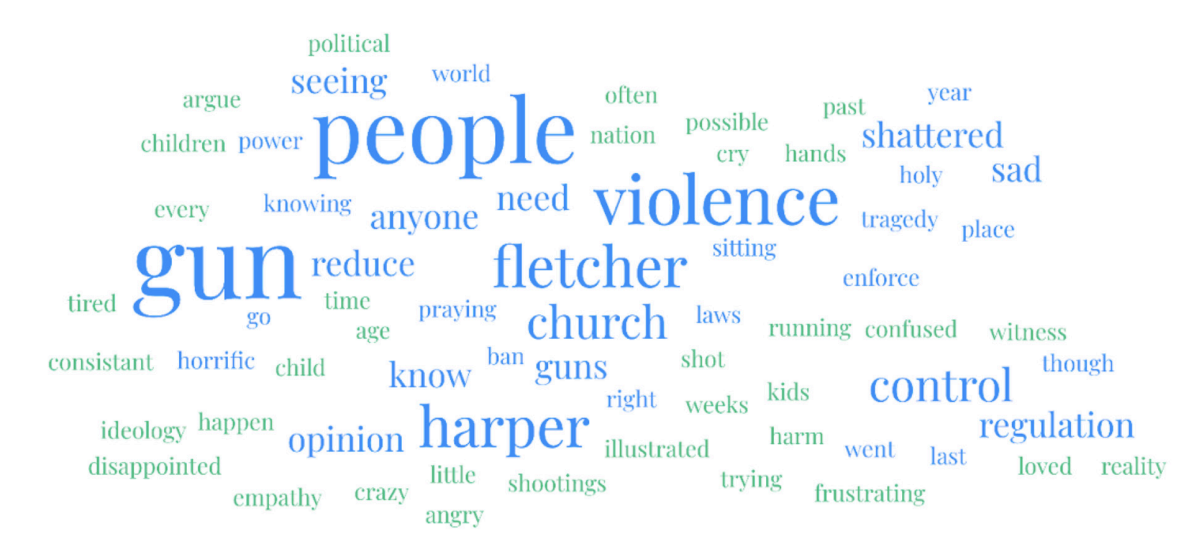
To gather student perspectives for our editorial, we shared a Google Form with the school asking: “Please share any thoughts, feelings, or experiences you’d like to express about the Annunciation shooting. Responses can be as short as a sentence or as long as a full paragraph.” We then created this word cloud to visually represent the responses. The largest words are those mentioned most often, showing what resonated within the Breck community.
398,000.
According to the Washington Post, that is approximately the number of students that experienced gun violence at school from 1999 to today. And counting.
Just like too many issues in America, this one has become polarized and politicized. But it shouldn’t be. Taking action isn’t a political issue, it’s a human one. Lawmakers should work across the aisle to pass bills to protect students.
As students, most of us don’t have the right to vote. We can protest, sign petitions, and write articles like this one, but we can’t elect lawmakers who will make laws guaranteeing our safety. This is normal. While no one expects a six year old, or even a sixteen year old to be a full-fledged participant in society, this only increases the responsibility on adults who are.
This responsibility does not only extend to our parents, school, and community — it extends to our state lawmakers, governors, and federal representatives.
Even if the tragedy at Annunciation felt like a one-time event, in reality it was not, and our lawmakers should be obligated to respond. Any shooting that occurs should be a call to action; if lawmakers feel that one solution is infeasible—constitutionally, practically, or otherwise—they should put all of their efforts towards finding one that is. They should keep trying, without excuses, until they find something, anything, that works. A solution should not be good-enough, or a work in progress, it should work.
As lawmakers consider additional measures of gun control in our state, we hope they think beyond political expediency, and instead ask themselves, will this work? Will this eliminate school shootings in our state? And if not, what will?
And as we consider the additional solutions that lawmakers have proposed, we ask why only now? As elected officials, they should have been aware of the danger to students and teachers long before a shooting occurred in our state. If these are solutions, why weren’t they passed already?
And beyond Minnesota, why is this not a national issue? Why isn’t every state’s legislature holding a special session? Why should a student’s risk of exposure to gun violence in school be contingent on the state they live in? All lawmakers share a responsibility to protect children everywhere, and a child in Oregon or Georgia should not have to worry about going to school more than a child in Minnesota.
It takes a village. That doesn’t just mean parents who send their children to school hoping they will be safe. That doesn’t just mean teachers and administrators, who work on school security policies and drills. That doesn’t just mean communities, which band together in the wake of shootings to support those who have lost a child and those impacted.
It means leaders. Every leader in our village with the ability to make a difference. It means action. It means change. And it means doing whatever it takes to ensure that no student has to fear for their lives at school.
